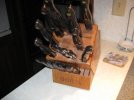Alright, I am in the process of upgrading everything I own, to high quality, long-lasting, and enjoyable to own items (except my furniture, because PCSing your furniture sucks). Right now I am focused on my kitchen items. I use a crappy wal-mart knife set right now and it wouldn't be worth my time to sharpen these blades. I want a good knife set to use, and I could use some help from the BF community.
So I have some questions:
What kind of steel is preferred? I would assume that high stain resistance steels such as 420/440 and VG-10 are good? I don't care if I have to keep them out of the dishwasher (dishwashing is my wife's task anyway).
What brands should I start looking at? I am stationed in Germany right now, so I might go off-post and start looking at some of the German stores, but I need brand recommendations.
Do you guys recommend buying as a set, or individually? I like the idea of having all of the blades match, but buying individually lets you choose the specific blades you like.
What is the cheapest I can get a good quality set for? I want atleast a large chef knife, a medium sized 4" (or so) utility knife (probably be most used), and a smaller paring/slicer.
Thanks in advance guys.
So I have some questions:
What kind of steel is preferred? I would assume that high stain resistance steels such as 420/440 and VG-10 are good? I don't care if I have to keep them out of the dishwasher (dishwashing is my wife's task anyway).
What brands should I start looking at? I am stationed in Germany right now, so I might go off-post and start looking at some of the German stores, but I need brand recommendations.
Do you guys recommend buying as a set, or individually? I like the idea of having all of the blades match, but buying individually lets you choose the specific blades you like.
What is the cheapest I can get a good quality set for? I want atleast a large chef knife, a medium sized 4" (or so) utility knife (probably be most used), and a smaller paring/slicer.
Thanks in advance guys.

